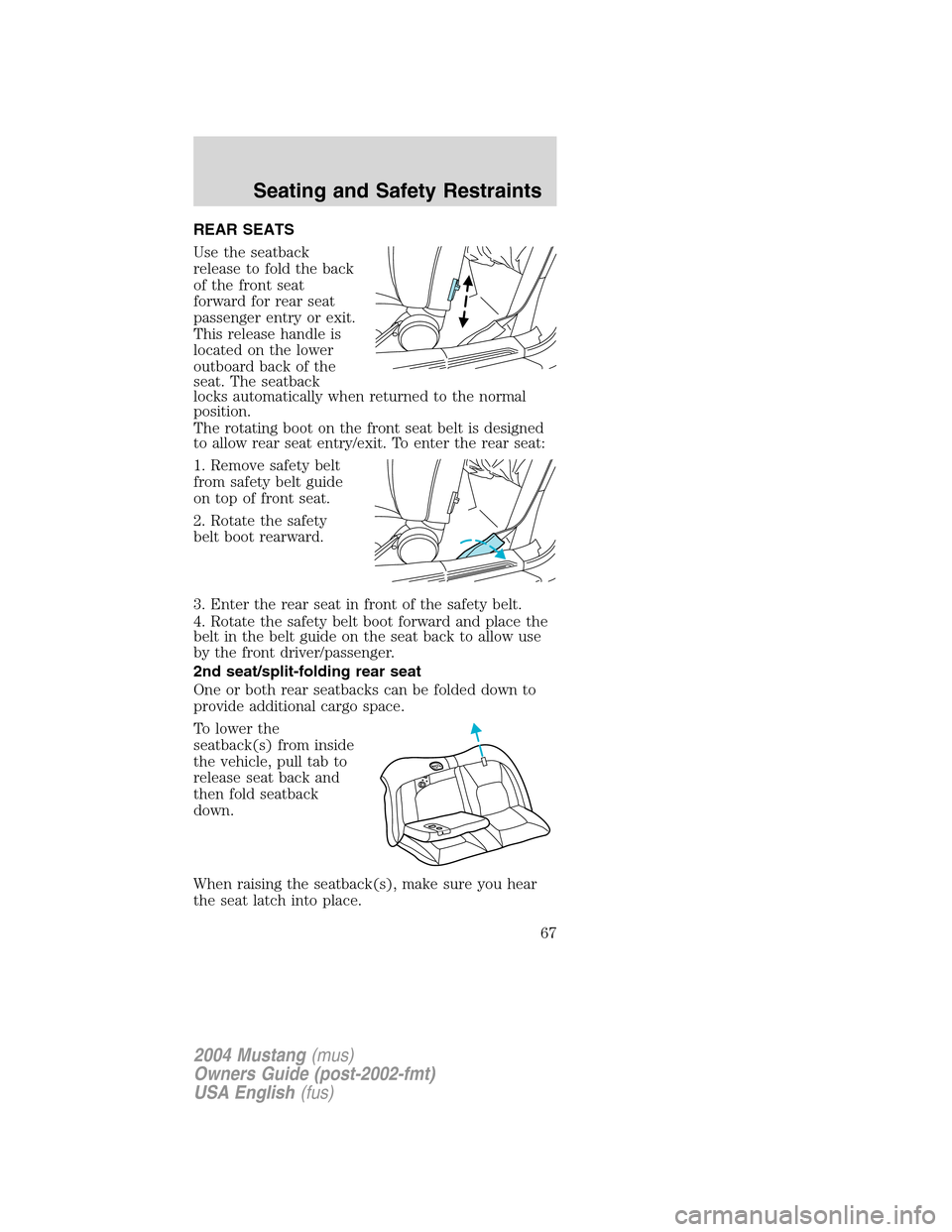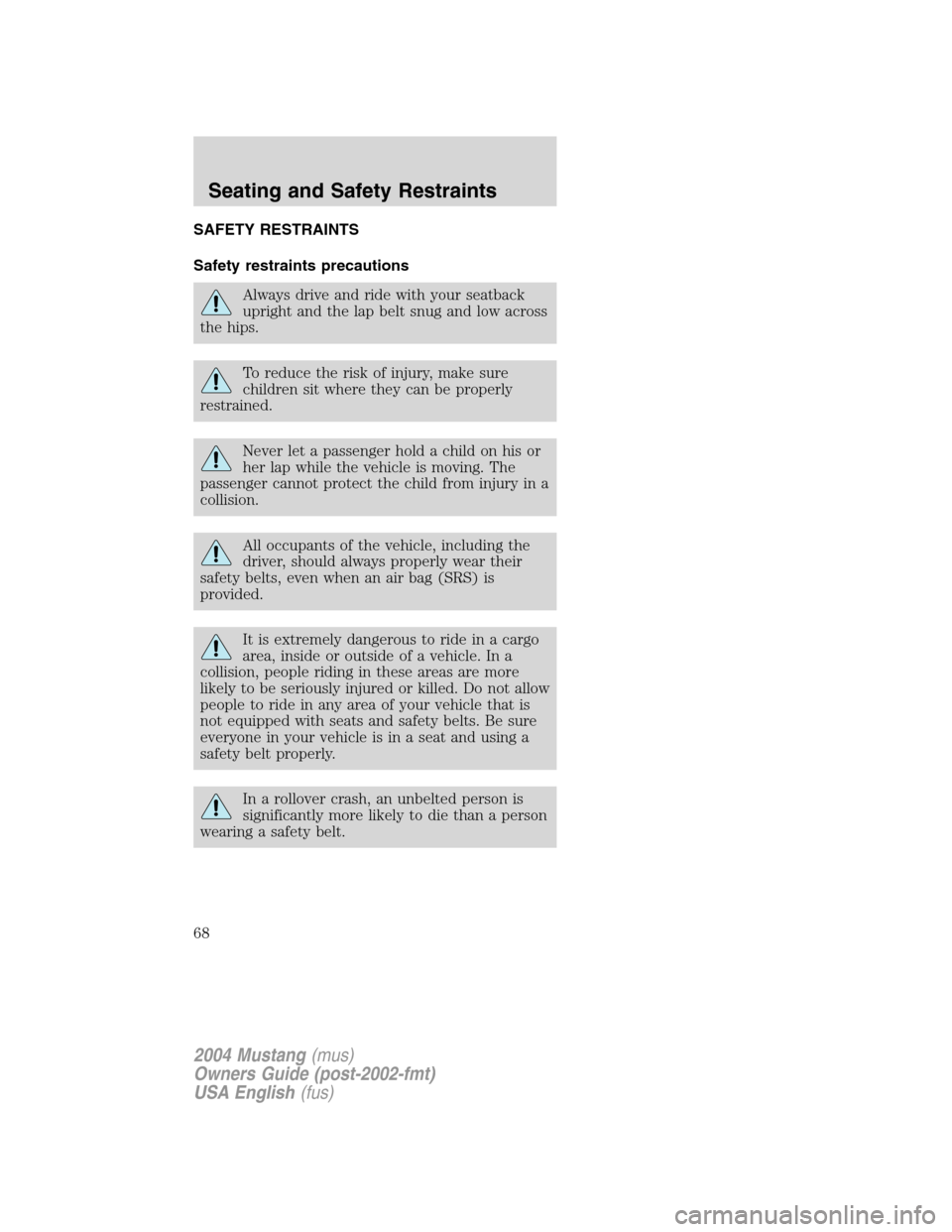Page 7 of 240

•the use of restraint systems including seat belts
by the driver and passengers,
•information about the performance of various
systems and modules in the vehicle, and
•information related to engine, throttle, steering,
brake or other system status.
Any of this information could potentially include
information regarding how the driver operates the
vehicle, potentially including but not limited to
information regarding vehicle speed, brake or
accelerator application, or steering input. This
information may be stored during regular operation
or in a crash or near crash event.
This stored information may be read out and used
by:
•Ford Motor Company.
•service and repair facilities.
•law enforcement or government agencies.
•others who may assert a right or obtain your
consent to know such information.
Notice to owners of Cobra vehicles
Before you drive your vehicle, be sure to read the
“SVT Cobra Owner’s Guide Supplement.”This book
contains important operation and maintenance
information.
MIDDLE EAST/NORTH AFRICA VEHICLE
SPECIFIC INFORMATION
For your particular global region, your vehicle may
be equipped with features and options that are
different from the ones that are described in this
Owner Guide; therefore, a supplement has been
supplied that complements this book. By referring to
the pages in the provided supplement, you can
properly identify those features, recommendations
and specifications that are unique to your vehicle.
Refer to this Owner Guide for all other
required information and warnings.
2004 Mustang(mus)
Owners Guide (post-2002-fmt)
USA English(fus)
Introduction
7
Page 8 of 240
These are some of the symbols you may see on your
vehicle.
Vehicle Symbol Glossary
Safety Alert
See Owner’s Guide
Fasten Safety BeltAir Bag-Front
Air Bag-SideChild Seat
Child Seat
Installation WarningChild Seat Lower
Anchor
Child Seat Tether
AnchorBrake System
Anti-Lock Brake
SystemBrake Fluid -
Non-Petroleum
Based
Traction ControlAdvanceTrac�
Master Lighting
SwitchHazard Warning
Flasher
Fog Lamps-FrontFuse Compartment
Fuel Pump ResetWindshield
Wash/Wipe
Windshield
Defrost/DemistRear Window
Defrost/Demist
Power Windows
Front/RearPower Window
Lockout
2004 Mustang(mus)
Owners Guide (post-2002-fmt)
USA English(fus)
Introduction
8
Page 12 of 240

brake indicates low brake fluid level and the brake
system should be inspected immediately by your
servicing dealership.
Driving a vehicle with the brake system
warning light on is dangerous. A significant
decrease in braking performance may occur. It will
take you longer to stop the vehicle. Have the
vehicle checked by your dealer immediately.
Anti-lock brake
system:If the ABS
light stays illuminated
or continues to flash, a
malfunction has been detected, have the system
serviced immediately. Normal braking is still
functional unless the brake warning light also is
illuminated.
Air bag readiness:If
this light fails to
illuminate when
ignition is turned to ON, continues to flash or
remains on, have the system serviced immediately. A
chime will also sound when a malfunction in the
supplemental restraint system has been detected.
Safety belt:Reminds
you to fasten your
safety belt. A chime
will also sound to
remind you to fasten your safety belt.
Charging system:
Illuminates when the
battery is not charging
properly.
Low fuel:Illuminates
when the fuel level in
the fuel tank is at or
near empty. Refer to
Fuel gaugein this chapter).
ABS
AIR
BAG
LOW
FUEL
2004 Mustang(mus)
Owners Guide (post-2002-fmt)
USA English(fus)
Instrument Cluster
12
Page 64 of 240
SEATING
Notes:
Reclining the seatback can cause an
occupant to slide under the seat’s safety
belt, resulting in severe personal injuries in the
event of a collision.
Do not pile cargo higher than the seatbacks
to reduce the risk of injury in a collision or
sudden stop.
Adjustable head restraints
Head restraints help to limit head motion in the
event of a rear collision. Adjust your head restraint
so that it is located directly behind your head or as
close to that position as possible.
The head restraints can
be moved up and
down.
4–way head restraints (if equipped)
Your vehicle may have
head restraints that
can be moved in four
directions:
•up and down
•forward or backward
Adjusting the front manual seat (if equipped)
Never adjust the driver’s seat or seatback
when the vehicle is moving.
2004 Mustang(mus)
Owners Guide (post-2002-fmt)
USA English(fus)
Seating and Safety Restraints
64
Page 65 of 240
Always drive and ride with your seatback
upright and the lap belt snug and low across
the hips.
Lift handle to move
seat forward or
backward.
Pull lever up to adjust
seatback.
Using the power lumbar support (if equipped)
The power lumbar
control is located on
the outboard side of
the seat.
Press one side of the
control to adjust
firmness.
Press the other side of the control to adjust
softness.
Adjusting the front power seat (if equipped)
Never adjust the driver’s seat or seatback
when the vehicle is moving.
Do not pile cargo higher than the seatbacks
to avoid injuring people in a collision or
sudden stop.
2004 Mustang(mus)
Owners Guide (post-2002-fmt)
USA English(fus)
Seating and Safety Restraints
65
Page 66 of 240
Always drive and ride with your seatback
upright and the lap belt snug and low across
the hips.
Reclining the seatback can cause an
occupant to slide under the seat’s safety
belt, resulting in severe personal injuries in the
event of a collision.
The control is located on the front of the driver’s
seat.
Press front to raise or
lower the front portion
of the seat cushion.
Press rear to raise or
lower the rear portion
of the seat cushion.
Press the control to
move the seat forward,
backward, up or down.
2004 Mustang(mus)
Owners Guide (post-2002-fmt)
USA English(fus)
Seating and Safety Restraints
66
Page 67 of 240

REAR SEATS
Use the seatback
release to fold the back
of the front seat
forward for rear seat
passenger entry or exit.
This release handle is
located on the lower
outboard back of the
seat. The seatback
locks automatically when returned to the normal
position.
The rotating boot on the front seat belt is designed
to allow rear seat entry/exit. To enter the rear seat:
1. Remove safety belt
from safety belt guide
on top of front seat.
2. Rotate the safety
belt boot rearward.
3. Enter the rear seat in front of the safety belt.
4. Rotate the safety belt boot forward and place the
belt in the belt guide on the seat back to allow use
by the front driver/passenger.
2nd seat/split-folding rear seat
One or both rear seatbacks can be folded down to
provide additional cargo space.
To lower the
seatback(s) from inside
the vehicle, pull tab to
release seat back and
then fold seatback
down.
When raising the seatback(s), make sure you hear
the seat latch into place.
2004 Mustang(mus)
Owners Guide (post-2002-fmt)
USA English(fus)
Seating and Safety Restraints
67
Page 68 of 240

SAFETY RESTRAINTS
Safety restraints precautions
Always drive and ride with your seatback
upright and the lap belt snug and low across
the hips.
To reduce the risk of injury, make sure
children sit where they can be properly
restrained.
Never let a passenger hold a child on his or
her lap while the vehicle is moving. The
passenger cannot protect the child from injury in a
collision.
All occupants of the vehicle, including the
driver, should always properly wear their
safety belts, even when an air bag (SRS) is
provided.
It is extremely dangerous to ride in a cargo
area, inside or outside of a vehicle. In a
collision, people riding in these areas are more
likely to be seriously injured or killed. Do not allow
people to ride in any area of your vehicle that is
not equipped with seats and safety belts. Be sure
everyone in your vehicle is in a seat and using a
safety belt properly.
In a rollover crash, an unbelted person is
significantly more likely to die than a person
wearing a safety belt.
2004 Mustang(mus)
Owners Guide (post-2002-fmt)
USA English(fus)
Seating and Safety Restraints
68